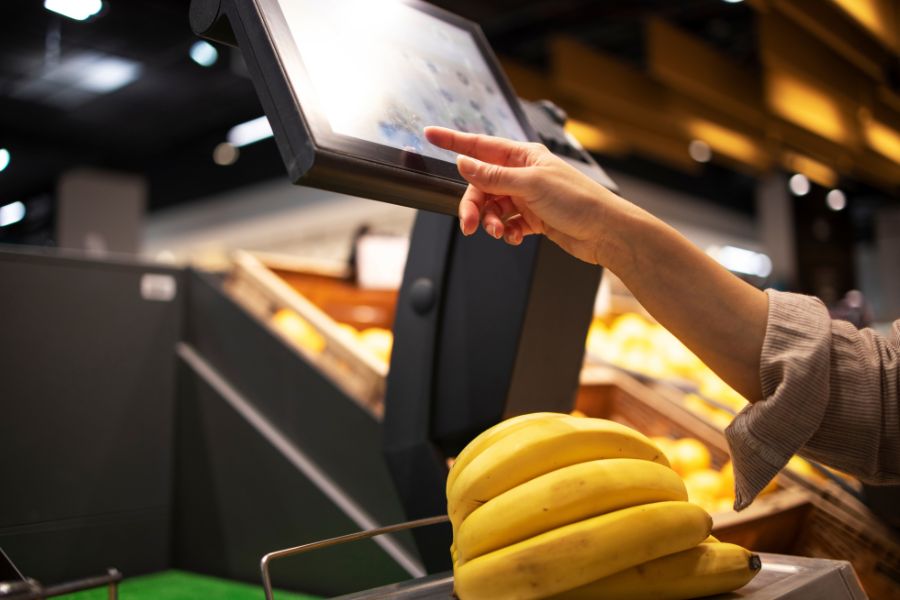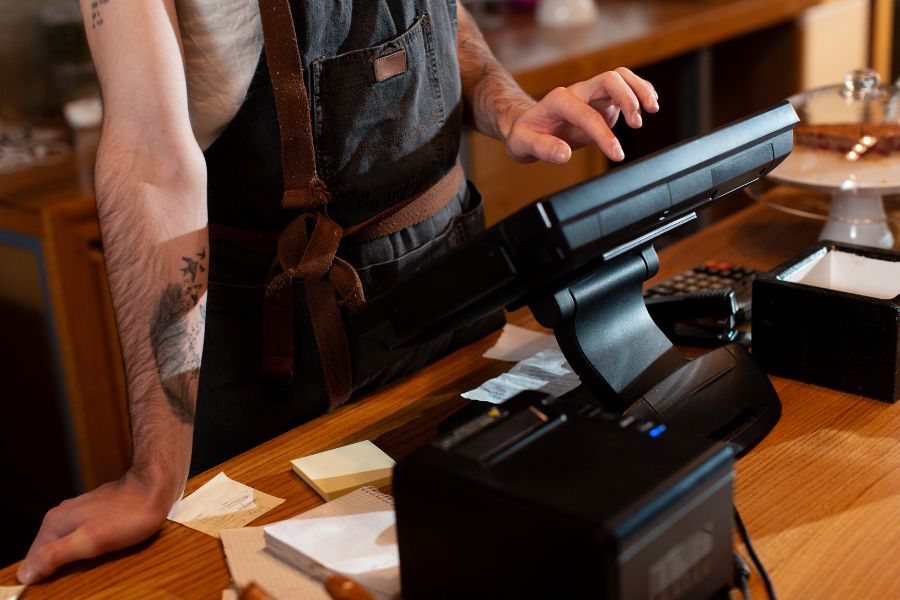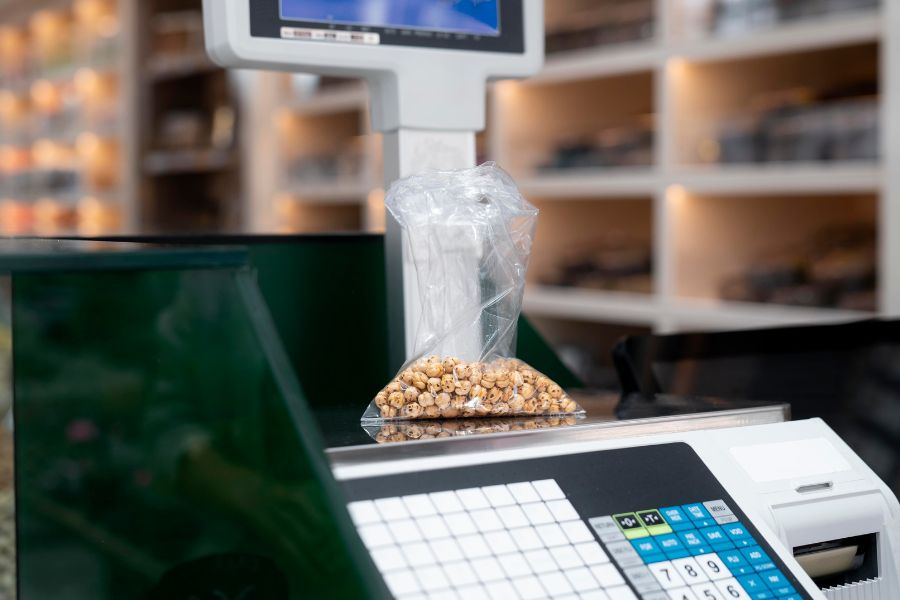Nobody enjoys standing in line forever just to buy tickets, it’s a quick way to turn excitement into frustration. That’s why having a solid point of sale ticketing system at your box office can feel like a lifesaver. It helps staff handle those busy moments easily, keeps lines moving fast, and organizes everything you need right in one place. No more scattered data or guesswork!
When your ticketing process is smoother, customers leave happier, staff stress less, and you’re able to see clearly what’s happening behind the scenes. Basically, you’re trading in the old-school hassle for something way more manageable. Let’s be honest, your customers will thank you for making their experience better, and your team will love having fewer headaches to deal with.
Let’s take a closer look at how this kind of setup can make ticketing smoother, faster, and more efficient.
Highlights:
- A POS ticketing system connects sales, check-ins, and customer data in one place, making events easier to manage and more consistent from start to finish.
- You can elevate your ticketing system by using real-time data, automating routine tasks, and giving staff mobile tools to work faster and serve guests better.
What Is a Point of Sale Ticketing System?
A point of sale ticketing system blends transaction processing with event management, making it easier to handle sales, seating, and attendees in one place. Instead of juggling spreadsheets or disconnected tools, businesses can keep everything streamlined. The system tracks each ticket sold, processes payments, issues digital or printed tickets, and logs all data in real time, reducing errors and making operations smoother.
One major advantage is instant seat availability. Customers can see open spots right away and book without delays, while staff get live updates to prevent overbooking or missed opportunities during peak sales. Many systems also connect with marketing and loyalty programs, helping businesses recognize repeat customers and create targeted promotions.
In short, a POS ticketing system simplifies event management by combining hardware, like card readers and ticket printers, with software that tracks everything from seating to post-event reports. The result? Faster transactions, clearer insights, and a more seamless experience for both staff and attendees.
Benefits of Upgrading to a POS Ticketing System
Moving from manual processes or outdated tools to a modern point of sale ticketing system brings smoother operations, better data insights, and quicker check-ins. With everything connected, hardware, software, and real-time data, your team can focus less on routine tasks and more on creating a seamless experience for guests.
- Faster ticket sales, shorter lines. Speedy checkouts mean less waiting and more satisfied attendees.
- Better customer service. Fewer manual steps reduce errors, ensuring accurate orders and a hassle-free experience.
- Live data, smarter decisions. Track ticket sales, inventory, and attendance in real time, keeping everything in sync.
- Automated inventory and reporting. No more guesswork, seat availability and ticket quotas update instantly with report & analytics.
- More ways to pay, more sales. Accept credit cards, mobile payments, and contactless options to meet every customer’s preference.
Upgrading isn’t just about efficiency, it’s about giving both staff and attendees a smoother, more enjoyable experience.
Key Features to Look For in a Point of Sale Ticketing System
Picking a point of sale ticketing system isn’t just about finding one with a sleek design. The right system makes transactions smoother, helps staff work efficiently, and keeps everything running without a hitch, even on the busiest nights. Here are some must-have features to consider:
Easy to Use
A straightforward interface means less time spent on training and fewer mistakes during high-pressure events. Staff should be able to navigate the system quickly, from selecting seats to processing payments, without fumbling through complex menus. A well-designed POS keeps things moving, especially when there’s a line of customers waiting.
Multiple Payment Options
Not everyone wants to swipe a credit card, some prefer tapping their phone, scanning a QR code, or even paying with cash. A good ticketing system supports a variety of payment methods so customers can choose what works for them. The easier you make it to pay, the less likely someone is to walk away without completing their purchase.
Seamless Integration
A POS that connects with other tools, like customer relationship management (CRM) software or email marketing platforms, helps venues track returning guests, manage ticket inventory, and analyze sales trends. When data flows smoothly between systems, it’s easier to make informed decisions and improve the overall experience for both staff and attendees.
Built for Growth
Whether you’re selling tickets for a small theater or a massive stadium, the system should handle different volumes without slowing down. A venue might start with just a few thousand sales per month but could expand rapidly. A flexible POS grows with demand, ensuring reliable performance whether you’re selling 100 tickets or 10,000.
Live Sales Data
Seeing real-time numbers on ticket sales and seat availability helps staff make smart adjustments on the fly. If Friday night’s show is filling up faster than expected, it might be time to promote the remaining seats or add extra staff. A system with live reporting allows for quick decisions that can maximize attendance and revenue.
Offline Backup
Internet issues shouldn’t bring ticket sales to a halt. Some point of sale ticketing systems include an offline mode, allowing transactions to continue even when the connection drops. Once the system goes back online, everything syncs up automatically. This keeps the operation running smoothly, even during unexpected outages.
In short, a great ticketing POS system does more than process payments, it simplifies operations, supports customers’ preferences, and grows with your needs. Prioritizing these key features can help ensure smooth transactions and a better experience for both staff and attendees.
6 Steps to Implement a POS Ticketing Solution
Rolling out a new point of sale ticketing system can feel overwhelming, but breaking it into clear steps makes the transition smoother.
1. Take Stock of Your Current System
Start by identifying what’s working, and what isn’t. Are frequent overbookings causing chaos? Do staff members spend too much time on manual data entry? Jot down the biggest pain points so you can focus on solutions that truly address them.
2. Research and Compare Your Options
Not all POS systems are built the same. Look at key features, pricing, and user reviews. Watch live demos to see how different platforms handle seat mapping, payments, and real-time updates. Pay extra attention to ease of use, security, and whether the system integrates seamlessly with tools you already rely on.
3. Plan for a Smooth Integration
A great system should work with your existing setup, not against it. If you already use marketing software or seat-scanning equipment, confirm that your new POS syncs properly. Some systems have built-in compatibility, while others require third-party connectors, either way, make sure everything runs smoothly before launch.
4. Train Your Team the Right Way
Even the best system won’t work if your staff isn’t comfortable using it. Offer hands-on training, whether through tutorials, group sessions, or trial transactions. Some employees might need extra practice scanning tickets or explaining new checkout steps to customers. If possible, run a test event before going live and provide quick-reference guides for common tasks.
5. Track Performance and Adjust as Needed
Expect a learning curve. Use built-in reports to monitor sales trends, line speeds, and seat availability. If certain sections aren’t selling, adjust pricing. If customers struggle with a particular step, tweak training or refine the process. The first few events will provide valuable insights, pay attention and fine-tune accordingly.
6. Get Feedback from Customers
Your audience’s experience matters just as much as your team’s. Ask attendees for their thoughts, was seat selection intuitive? Did checkout feel easy? Small tweaks based on real feedback can make future events even smoother.
Practical Strategies to Elevate Your Ticketing System
Even the best point of sale ticketing system won’t reach its full potential without the right strategies. Small tweaks, like using real-time data, rewarding loyal customers, or improving mobile access, can make a big difference.
In this section, we will go through the strategies to maximize your system’s impact and stay ahead in the ticketing game.
Use Data to Make Smarter Decisions
Your POS system likely collects more data than you realize — ticket sales by section, time of purchase, customer type, and more. Use that information to make strategic calls. For example, if weekday matinees consistently underperform, consider bundling them with food vouchers or offering group discounts to schools and offices.
On the other hand, if premium seats for weekend shows sell out within hours, test a tiered pricing model or introduce early access perks for high-demand events. Over time, these adjustments can reduce no-shows, improve revenue, and make scheduling less of a guessing game.
Personalize Customer Engagement
A one-size-fits-all message rarely gets attention. If your POS captures customer preferences and purchase history, put that data to work. Send targeted emails with show recommendations based on past attendance, or offer discounted upgrades to repeat buyers.
For example, someone who’s attended every jazz event over the past year might appreciate early access to an upcoming jazz festival. If your system includes loyalty tracking, display point balances at checkout or suggest rewards they’re close to earning. These personal touches build stronger connections and more repeat visits.
Simplify Ticket Sales, Payments, and Staff Scheduling
Merging these tasks into one system eliminates unnecessary back-and-forth. Staff can check seating maps, apply loyalty perks, and process payments all in one place.
At the same time, managers can track sales trends, monitor staffing gaps, or adjust shift assignments based on real-time demand. This kind of setup removes guesswork during peak hours and keeps the focus where it belongs: on attendees, not admin work.
Make Mobile a Priority
A modern ticketing system should work effortlessly on mobile. That means a fast, easy-to-use interface for buying tickets and scanning them at the door.
Staff should be able to troubleshoot issues, check availability, or handle payments from a tablet, no need to walk back to a fixed terminal. This kind of flexibility keeps lines moving and customer satisfaction high, especially at large or outdoor venues.
Automate Repetitive Tasks
Routine tasks, like sending confirmation emails, updating seat availability, or printing ticket slips, should run automatically. This frees up staff to focus on customer interactions and event logistics instead of manual updates.
For instance, if someone buys the last VIP seat online, that seat should instantly disappear from in-person terminals too. Automation keeps everyone on the same page and gives staff more freedom to focus on live customer needs, not behind-the-scenes fixes.
Train Staff for Long-Term Success
Even the best system won’t deliver results if your team doesn’t know how to use it. Regular training sessions, especially after software updates or before major events, help staff stay sharp. Role-play common scenarios like last-minute seat changes or mobile check-in issues to build confidence and speed.
When your team knows the system inside out, they spend less time troubleshooting and more time creating a smooth guest experience.
A great POS ticketing system isn’t just about the technology, it’s about how you use it. By making data-driven decisions, personalizing customer interactions, and optimizing mobile features, you can create a smoother, more efficient ticketing experience for both staff and attendees.
Transform Your Ticketing Experience with ConnectPOS
Managing ticket sales shouldn’t be a hassle, whether you’re running a stadium event, a theme park, or a concert tour. ConnectPOS, a cloud-based point of sale ticketing system, simplifies the process with real-time tracking, seamless payment options, and multi-device compatibility. Staff can check seat inventory instantly, process payments in multiple ways, and monitor sales performance on the go.
With live dashboards, you’ll always know which seats are still available, which event times are selling out, and how sales compare across different channels. Here’s what makes ConnectPOS a powerful event POS for venues of all sizes:
- Omnichannel Ticketing: Sell tickets across in-person booths, mobile apps, or online stores.
- Fast & Secure Payments: Support a wide variety of payment choices, from cash to digital wallets.
- Real-Time Tracking: Observe seat availability and revenue progress with user-friendly dashboards.
- Integrated CRM: Link loyalty programs or marketing campaigns to deepen customer engagement.
- Multi-Device Usage: Equip staff with tablets or smartphones, letting them assist customers from anywhere in the venue.
- Scalability: Adaptable to single-hall shows or multi-venue operations.
- Customizable Ticket Types: Issue physical or e-tickets with barcodes or wristbands for simpler entry.
- Dynamic Pricing & Promotions: Adjust seat pricing or craft bundle deals and limited-time offers.
- Advanced Reporting & Analytics: Use in-depth sales data and audience behavior trends for strategic planning.
- Event & Seat Management: Create seat maps, handle VIP sections, and run separate ticket categories.
- Self-Check-In & Contactless Entry: Let visitors scan codes at entrances, cutting out friction.
- Refund & Cancellation Management: Provide hassle-free refunds and ticket changes without messy back-and-forth.
- Multi-Location & Franchise Support: Sync ticket data across different event spaces or brand affiliates.
- User Roles & Permissions: Protect data and keep tasks organized with designated staff roles.
- Third-Party Integration: Expand functionality by pairing with finance, marketing, or enterprise resource planning tools.
- Offline Mode: Continue selling tickets if the internet falters, with data synced when the network returns.
- Multi-Language & Multi-Currency Support: Appeal to international crowds in their preferred language and currency.
- Built-in Marketing Tools: Automate confirmations, send reminders, and target new customers for your events.
ConnectPOS streamlines operations for venues by integrating convenience, real-time data, and an intuitive design, even during peak demand.
FAQs: Point of Sale Ticketing System
1. How does a POS ticketing system improve event management?
It connects ticket sales, inventory tracking, and attendee data in a single location. Staff can track real-time inventory, upsell or cross-sell effectively, and even analyze customer preferences. This leads to smoother events with fewer delays.
2. Can ConnectPOS handle a spike in ticket sales during busy events?
Yes. ConnectPOS is engineered for large transaction volumes and syncs seat availability in real time. This consistency ensures that your staff and online portals have correct figures at all times.
3. Does ConnectPOS support self-service ticketing and mobile scanning?
Absolutely. ConnectPOS includes self-check-in options, QR code scanning, and contactless entry to cut wait times and give fans a quicker experience.
Final Thoughts
A point of sale ticketing system’s responsibilities are not only about handling transactions — it connects key parts of the event experience, from seat selection to check-in, while giving you real-time insights to guide better decisions. When operations run smoothly and customer preferences are factored in, staff can stay focused on delivering a hassle-free, memorable experience that keeps people coming back.
Planning a small local show or managing a multi-day event? The right ticketing setup brings structure, speed, and flexibility to every part of the process.
If you’re ready to take your ticketing operations to the next level, ConnectPOS is here to help. Get in touch with our team and see how we can make your events run smoother while keeping lines short and customers happy.
ConnectPOS is a all-in-one point of sale solution tailored to meet your eCommerce POS needs, streamline business operations, boost sales, and enhance customer experience in diverse industries. We offer custom POS with features, pricing, and plans to suit your unique business requirements.




